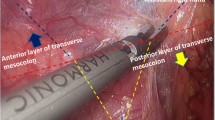Abstract
Purpose
Although D2 lymphadenectomy is currently considered a standard procedure for advanced gastric cancer (GC) worldwide, there is room for discussion about the appropriate range of suprapancreatic D2 lymphadenectomy. Focusing on the posterior hepatic plexus (PHP), which is not well recognized, we developed a surgical technique of suprapancreatic D2 lymphadenectomy, which we have called PHP-D2, and its short-term and long-term efficacies were evaluated in comparison with non-PHP-D2.
Methods
GC patients who underwent distal gastrectomy with D2 lymphadenectomy between July 2006 and May 2013 were enrolled, from which patients who had peritoneal metastasis and/or were peritoneal cytology-positive during surgery were excluded. Their medical records were retrospectively reviewed.
Results
Ninety-two patients (non-PHP-D2: 48, PHP-D2: 44) were enrolled. Shorter operation time (330 min vs 275 min, p < 0.0001) and less blood loss (290 mL vs 125 mL, p < 0.0001) were observed in PHP-D2, and no pancreatic fistulas were observed in PHP-D2. More lymph nodes of #11p (1 vs 1.5, p = 0.0328) and #12a lymph nodes (0 vs 1, p = 0.0034) were retrieved in PHP-D2, with no significant differences in #8a and #9 lymph nodes. Lymphatic recurrence was significantly less in PHP-D2 (p = 0.0166), and univariate and multivariate analyses showed that non-PHP-D2 was a significant risk factor for lymphatic recurrence (p = 0.0158), although there were no significant differences between non-PHP-D2 and PHP-D2 in 5-year overall survival and 5-year relapse-free survival.
Conclusion
PHP-D2 was a safe and feasible procedure that had the potential to reduce lymphatic recurrence, and it can be a standard procedure of D2 lymphadenectomy for advanced GC.




Similar content being viewed by others
References
Sung H, Ferlay J, Siegel RL, Laversanne M, Soerjomataram I, Jemal A, Bray F (2021) Global Cancer Statistics 2020: GLOBOCAN estimates of incidence and mortality worldwide for 36 cancers in 185 countries. CA Cancer J Clin 71(3):209–249
Hatta W, Gotoda T, Kanno T, Yuan Y, Koike T, Moayyedi P, Masamune A (2020) Prevalence and risk factors for lymph node metastasis after noncurative endoscopic resection for early gastric cancer: a systematic review and meta-analysis. J Gastroenterol 55(8):742–753
Japanese Gastric Cancer A (2021) Japanese gastric cancer treatment guidelines 2018 (5th edition). Gastric Cancer 24(1):1–21
Songun I, Putter H, Kranenbarg EM, Sasako M, van de Velde CJ (2010) Surgical treatment of gastric cancer: 15-year follow-up results of the randomised nationwide Dutch D1D2 trial. Lancet Oncol 11(5):439–449
Suda K, Nakauchi M, Inaba K, Ishida Y, Uyama I (2016) Minimally invasive surgery for upper gastrointestinal cancer: our experience and review of the literature. World J Gastroenterol 22(19):4626–4637
Ren K, Yi SQ, Dai Y, Kurosawa K, Miwa Y, Sato I (2020) Clinical anatomy of the anterior and posterior hepatic plexuses, including relations with the pancreatic plexus: a cadaver study. Clin Anat 33(5):630–636
Lee SW, Kawai M, Tashiro K, Bouras G, Kawashima S, Tanaka R, Nomura E, Uchiyama K (2017) Laparoscopic distal gastrectomy with D2 lymphadenectomy followed by intracorporeal gastroduodenostomy for advanced gastric cancer: technical guide and tips. Transl Gastroenterol Hepatol 2:84
Kuroda S, Kikuchi S, Hori N, Sakamoto S, Kagawa T, Watanabe M, Kubota T, Kuwada K, Ishida M, Kishimoto H, Uno F, Nishizaki M, Kagawa S, Fujiwara T (2017) Training system for laparoscopy-assisted distal gastrectomy. Surg Today 47(7):802–809
Japanese Gastric Cancer A (2011) Japanese Classification of Gastric Carcinoma: 3rd English edition. Gastric Cancer 14(2):101-112
Dindo D, Demartines N, Clavien PA (2004) Classification of surgical complications: a new proposal with evaluation in a cohort of 6336 patients and results of a survey. Ann Surg 240(2):205–213
Bracale U, Corcione F, Pignata G, Andreuccetti J, Dolce P, Boni L, Cassinotti E, Olmi S, Uccelli M, Gualtierotti M, Ferrari G, De Martini P, Bjelovic M, Gunjic D, Cuccurullo D, Sciuto A, Pirozzi F, Peltrini R (2021) Impact of neoadjuvant therapy followed by laparoscopic radical gastrectomy with D2 lymph node dissection in Western population: a multi-institutional propensity score-matched study. J Surg Oncol 124(8):1338–1346
Toyokawa T, Ohira M, Tanaka H, Minamino H, Sakurai K, Nagami Y, Kubo N, Yamamoto A, Sano K, Muguruma K, Tominaga K, Nebiki H, Yamashita Y, Arakawa T, Hirakawa K (2016) Optimal management for patients not meeting the inclusion criteria after endoscopic submucosal dissection for gastric cancer. Surg Endosc 30(6):2404–2414
Choi KK, Bae JM, Kim SM, Sohn TS, Noh JH, Lee JH, Choi MG, Kim S (2016) The risk of lymph node metastases in 3951 surgically resected mucosal gastric cancers: implications for endoscopic resection. Gastrointest Endosc 83(5):896–901
Author information
Authors and Affiliations
Contributions
Study conception and design: SK.
Acquisition of data: NK and SK.
Analysis and interpretation of data: NK, SK, YK, and ST.
Drafting of manuscript: NK and SK.
Critical revision of manuscript: SK, KN, YU, RY, FT, MN, SK, and TF
Corresponding author
Ethics declarations
Ethics approval
All procedures performed in studies involving human participants were in accordance with the ethical standards of the institutional and/or national research committee and with the 1964 Helsinki Declaration and its later amendments or comparable ethical standards.
Consent to participate
The IRB waived the requirement to obtain informed consent from the patients for this study because of the retrospective nature of the study.
Conflict of interest
The authors declare no competing interests.
Additional information
Publisher's note
Springer Nature remains neutral with regard to jurisdictional claims in published maps and institutional affiliations.
Supplementary Information
Below is the link to the electronic supplementary material.
Supplementary file1 (MP4 113134 KB)
Rights and permissions
About this article
Cite this article
Kanaya, N., Kuroda, S., Kakiuchi, Y. et al. Surgical technique of suprapancreatic D2 lymphadenectomy focusing on the posterior hepatic plexus for advanced gastric cancer. Langenbecks Arch Surg 407, 871–877 (2022). https://doi.org/10.1007/s00423-022-02437-4
Received:
Accepted:
Published:
Issue Date:
DOI: https://doi.org/10.1007/s00423-022-02437-4




